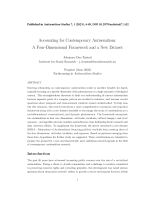Accounting for Contemporary Antisemitism: A Four-Dimensional Framework and a New Dataset
Author(s)
Publication Name
Publication Date
Abstract
Existing scholarship on contemporary antisemitism tends to sacrifice breadth for depth, typically focusing on a specific dimension of the phenomenon or a single national or ideological context. This myopia threatens to limit our understanding of current antisemitism because separate parts of a complex picture are studied in isolation, and because crucial questions about temporal and cross-national variation remain understudied. To help remedy this situation, this article introduces a more comprehensive conceptual and empirical framework along with a new dataset intended to encourage the study of antisemitism as a multidimensional, cross-national, and dynamic phenomenon. The framework provides a model for studying antisemitism in four core dimensions—attitudes, incidents, cultural imagery, and Jews’ exposure—and specifies relevant variables and indicators, thus facilitating future research and data collection efforts. To supplement the framework, the article introduces a new dataset (DIMA—Dimensions of Antisemitism) featuring publicly available data covering three of the four dimensions: attitudes, incidents, and exposure. Based on patterns emerging from these data, hypotheses for further study are suggested. These contributions are intended to prepare the ground for a new and theoretically more ambitious research agenda in the field of contemporary antisemitism research.
Topics
Antisemitism Antisemitism: Monitoring Surveys Statistics Main Topic: Antisemitism Antisemitism: Attitude Surveys
Genre
Geographic Coverage
Europe Global United States of America United Kingdom Germany France Belgium Netherlands Poland Spain Hungary Denmark Austria Italy Sweden Russia Canada
Copyright Info
CC-By Attribution 4.0 International
Original Language
Volume/Issue
7(1)
Page Number / Article Number
4-49
DOI
Bibliographic Information
Accounting for Contemporary Antisemitism: A Four-Dimensional Framework and a New Dataset. 2023: 4-49. https://archive.jpr.org.uk/10.31235/osf.io/adqkn




